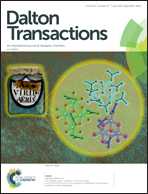A P–H functionalized Al/P-based frustrated Lewis pair – hydrophosphination of nitriles, ring opening with cyclopropenones and evidence of P![[double bond, length as m-dash]](https://www.rsc.org/images/entities/char_e001.gif) C double bond formation†
C double bond formation†
Abstract
Hydroalumination of R-P(H)-C![[triple bond, length as m-dash]](https://www.rsc.org/images/entities/char_e002.gif) C-tBu with bulky H-Al[CH(SiMe3)2]2 afforded the new P–H functionalized Al/P-based frustrated Lewis pair R-P(H)-C[
C-tBu with bulky H-Al[CH(SiMe3)2]2 afforded the new P–H functionalized Al/P-based frustrated Lewis pair R-P(H)-C[![[double bond, length as m-dash]](https://www.rsc.org/images/entities/char_e001.gif) C(H)-tBu]-AlR2 [R = CH(SiMe3)2; FLP 7]. A weak adduct of 7 with benzonitrile (8) was detected by NMR spectroscopy, but could not be isolated. tert-Butyl isocyanide afforded a similar, but isolable adduct (9), in which the isocyanide C atom was coordinated to aluminium. The unique reactivity of 7 became evident from its reactions with the heteroatom substituted nitriles PhO-C
C(H)-tBu]-AlR2 [R = CH(SiMe3)2; FLP 7]. A weak adduct of 7 with benzonitrile (8) was detected by NMR spectroscopy, but could not be isolated. tert-Butyl isocyanide afforded a similar, but isolable adduct (9), in which the isocyanide C atom was coordinated to aluminium. The unique reactivity of 7 became evident from its reactions with the heteroatom substituted nitriles PhO-C![[triple bond, length as m-dash]](https://www.rsc.org/images/entities/char_e002.gif) N, PhCH2S-C
N, PhCH2S-C![[triple bond, length as m-dash]](https://www.rsc.org/images/entities/char_e002.gif) N and H8C4N-C
N and H8C4N-C![[triple bond, length as m-dash]](https://www.rsc.org/images/entities/char_e002.gif) N. Hydrophosphination of the C
N. Hydrophosphination of the C![[triple bond, length as m-dash]](https://www.rsc.org/images/entities/char_e002.gif) N triple bonds afforded imines at room temperature which were coordinated to the FLP by Al–N and P–C bonds to yield AlCPCN heterocycles (10 to 12). These processes depend on substrate activation by the FLP. Diphenylcyclopropenone and its sulphur derivative reacted with 7 by addition of the P–H bond to a C–C bond of the strained C3 ring and ring opening to afford the fragment (Z)-Ph-C(H)
N triple bonds afforded imines at room temperature which were coordinated to the FLP by Al–N and P–C bonds to yield AlCPCN heterocycles (10 to 12). These processes depend on substrate activation by the FLP. Diphenylcyclopropenone and its sulphur derivative reacted with 7 by addition of the P–H bond to a C–C bond of the strained C3 ring and ring opening to afford the fragment (Z)-Ph-C(H)![[double bond, length as m-dash]](https://www.rsc.org/images/entities/char_e001.gif) C(Ph)-C-X-Al (X = O, S). The C–O or C–S groups were coordinated to the FLP to yield AlCPCX heterocycles (13 and 14). The thiocarbonyl derived compound 14 contains an internally stabilized phosphenium cation with a localized P
C(Ph)-C-X-Al (X = O, S). The C–O or C–S groups were coordinated to the FLP to yield AlCPCX heterocycles (13 and 14). The thiocarbonyl derived compound 14 contains an internally stabilized phosphenium cation with a localized P![[double bond, length as m-dash]](https://www.rsc.org/images/entities/char_e001.gif) C bond, a trigonal planar coordinated P atom and a short P
C bond, a trigonal planar coordinated P atom and a short P![[double bond, length as m-dash]](https://www.rsc.org/images/entities/char_e001.gif) C distance (168.9 pm). Insight into formation mechanisms, the structural and energetic properties of FLP 7 and compounds 13 and 14 was gained by quantum chemical DFT calculations.
C distance (168.9 pm). Insight into formation mechanisms, the structural and energetic properties of FLP 7 and compounds 13 and 14 was gained by quantum chemical DFT calculations.
![Graphical abstract: A P–H functionalized Al/P-based frustrated Lewis pair – hydrophosphination of nitriles, ring opening with cyclopropenones and evidence of P [[double bond, length as m-dash]] C double bond formation](/en/Image/Get?imageInfo.ImageType=GA&imageInfo.ImageIdentifier.ManuscriptID=C8DT01836G&imageInfo.ImageIdentifier.Year=2018)


 Please wait while we load your content...
Please wait while we load your content...
![[double bond, length as m-dash]](https://www.rsc.org/images/entities/h2_char_e001.gif) C double bond formation
C double bond formation